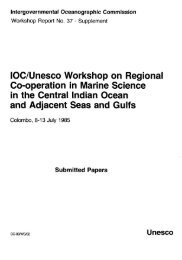Manual on sea level measurement and ... - unesdoc - Unesco
Manual on sea level measurement and ... - unesdoc - Unesco
Manual on sea level measurement and ... - unesdoc - Unesco
- No tags were found...
You also want an ePaper? Increase the reach of your titles
YUMPU automatically turns print PDFs into web optimized ePapers that Google loves.
Sea Level Measurement <strong>and</strong> Interpretati<strong>on</strong>Gauges for Tsunami WarningBernie Kil<strong>on</strong>sky, University of Hawaii Sea Level Center, USA.E-mail: kil<strong>on</strong>sky@hawaii.eduThe University of Hawaii Sea Level Center (UHSLC)has been providing high frequency tide gauge datafor tsunami warning to the Pacific Tsunami WarningCenter (PTWC) for 25 years. This has led to anemphasis <strong>on</strong> multiple-use platforms that have thestability <strong>and</strong> accuracy to measure l<strong>on</strong>g-term <strong>sea</strong> <strong>level</strong>variability <strong>and</strong> trends, <strong>and</strong> the range, durability, <strong>and</strong>sampling capability to m<strong>on</strong>itor tsunamis. Serving thisdual purpose has resulted in a robust system; stati<strong>on</strong>malfuncti<strong>on</strong>s can be detected <strong>and</strong> addressed quicklygiven the immediate access to the data, <strong>and</strong> <strong>on</strong>goingmaintenance in support of <strong>sea</strong> <strong>level</strong> m<strong>on</strong>itoringensures the sustainability of the stati<strong>on</strong>s betweeninfrequent tsunami events. Here we briefly describethe basic c<strong>on</strong>figurati<strong>on</strong> used by the UHSLC for atide gauge stati<strong>on</strong> that can also be used for tsunamiwarning.Sensors - Since no single sensor is optimal for measuringboth mean <strong>and</strong> high amplitude fluctuatingcomp<strong>on</strong>ents of <strong>sea</strong> <strong>level</strong>, a combinati<strong>on</strong> of water<strong>level</strong> sensors are used. The primary <strong>sea</strong> <strong>level</strong> sensor isa pulsed radar, with sampling fast enough (3 minuteaverages or shorter) to serve also as a sec<strong>on</strong>dary tsunamisensor. The primary tsunami sensor is a ventedpressure transducer reporting 1 minute or shorteraverages. The pressure time series, c<strong>on</strong>verted to water<strong>level</strong>, is usually adequate to fill any short gaps thatmay occur in the radar record. In many cases, a stati<strong>on</strong>with a preexisting float gauge is also retrofittedfor tsunami m<strong>on</strong>itoring. In these situati<strong>on</strong>s the floatgauge is maintained as a third sensor that provides abackup for <strong>sea</strong> <strong>level</strong> m<strong>on</strong>itoring. Water <strong>level</strong> switches<strong>and</strong> a tide staff are also included to m<strong>on</strong>itor the stabilityof the data over time.Power – All UHSLC stati<strong>on</strong>s rely <strong>on</strong> batteries chargedby solar panels for power. At many remote sites, localpower is not an opti<strong>on</strong>. More importantly, local poweris susceptible to failure in the event of a local earthquakeor tsunami inundati<strong>on</strong> event, in which case it isadvantageous to be isolated from the power grid. Mostof the UHSLC stati<strong>on</strong>s are at low- to mid- latitudesmaking solar a viable opti<strong>on</strong>. This may not be the ca<strong>sea</strong>t high latitude sites.Siting - Because tide gauges require a stable platform,most of the UHSLC stati<strong>on</strong>s are located <strong>on</strong> piers ordocks within harbors or atoll lago<strong>on</strong>s. In terms oftsunami m<strong>on</strong>itoring, this has the disadvantage of notsampling the wave signal in an open coast setting.Tsunami amplitudes <strong>and</strong> frequencies within a protectedharbor are likely to be significantly different than al<strong>on</strong>gan unprotected coast. This is of particular c<strong>on</strong>cern fortsunami modelers who may be trying to assimilate tidegauge data. On the other h<strong>and</strong>, unprotected sites tendto be exposed to swell <strong>and</strong> low frequency wave energythat may in some cases mask a small tsunami eventor limit the early detecti<strong>on</strong> of a larger event. In additi<strong>on</strong>,the stati<strong>on</strong> is less likely to be destroyed during atsunami if it is situated in a harbor. For these reas<strong>on</strong>s,we c<strong>on</strong>sider sitting a stati<strong>on</strong> within a harbor a betteropti<strong>on</strong> if the main c<strong>on</strong>cern is to determine whether atsunami threat is present or not.Communicati<strong>on</strong>s – The UHSLC tsunami m<strong>on</strong>itoringexperience in the Pacific has been in the c<strong>on</strong>text of abasin-wide warning system. Given that the Pacific issuch a large area, transmitting data from the stati<strong>on</strong> tothe warning center within an hour or so of collecti<strong>on</strong> istypically sufficient for m<strong>on</strong>itoring the basin-wide extentof a tsunami event. As such, the UHSLC has used theGOES satellite in the Pacific, with the transmissi<strong>on</strong> of2-4 minute averages every hour.Following the December 2004 tsunami, UHSLC istransiti<strong>on</strong>ing to 1 minute averages transmitted every15 minutes for basin wide m<strong>on</strong>itoring. This transmissi<strong>on</strong>rate has been accomplished using the JapaneseMeteorological Agency (JMA) <strong>and</strong> EUMETSAT geostati<strong>on</strong>arysatellites in the Indian Ocean, <strong>and</strong> the GOES inthe Pacific. For stati<strong>on</strong>s located within a 1-hour traveltime of a known tsunami generati<strong>on</strong> site, 15 sec<strong>on</strong>dsampling with a 5-minute transmissi<strong>on</strong> cycle is underc<strong>on</strong>siderati<strong>on</strong>. At present, this may be feasible <strong>on</strong> theGOES system but not for stati<strong>on</strong>s using either the JMAor EUMETSAT downlinks. For these stati<strong>on</strong>s, <strong>and</strong> insupport of partners installing nati<strong>on</strong>al tsunami warningsystems, UHSLC plans to use the INMARSAT BGANsystem. This applicati<strong>on</strong> is currently under developmentin the Indian Ocean.IOC <str<strong>on</strong>g>Manual</str<strong>on</strong>g>s <strong>and</strong> Guides No 14 vol IV75
















